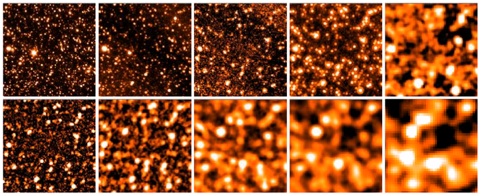One of the main Astrodeep goals is to update existing algorithms and if necessary develop new software to create high quality multi-wavelength catalogs extracted from both space and ground-based datasets. In this section you will be able to download all new software developed by Astrodeep members.
In order to fully exploit the extraordinary scientific benefits of this unique technology investment, a number of key technical problems first need to be faced. The most important challenge comes from the fact that the data are delivered by very different kinds of telescopes having widely different angular resolutions. This is most explicitly an issue for very deep surveys, which yield a high surface-density of detections, often resulting in “highly-confused” images. This results in conceptual and technical problems in a number of crucial areas. These include: the unambiguous identification and definition of individual objects; the measurement of accurate multi-frequency photometry in crowded fields from images with very different resolution and depth; the optimal extraction of the wealth of information contained in deep slit-less spectra obtained from space, exploiting the prior information available from ultra-deep imaging.

Postage stamp images of the same 5’x5’ region of the GOODS-N ranging from 3.6μm (upper left) to 500μm (bottom-right)
Members of our team have already developed and applied algorithms to solve or mitigate these problems. This project is on bringing together this expertise to develop, refine and combine these algorithms, test and properly validate their effectiveness on the deepest multi-frequency data. More specifically, we will test and further develop the available software for PSF-matched photometry, named TFIT and CONVPHOT. These will be applied to images with PSF FWHM ranging from sub-arcsec (WFC3, VLT) to ~2-3 arcsec (optical, Spitzer), in order to test whether it is possible to jump from WFC3-like resolution to the poorer-resolution Herschel images. We will explore and test other techniques for multi-band photometry (e.g. matched aperture photometry, cross correlation etc.). Thus a big part of this task will be devoted to cross-checking and comparing the various methods, with the goal of understanding and quantifying the differences, in order to fully characterize the various systematics and define the final recipes to adopt. Based on this experience a new version of a PSF-matching code will be released. Since slit-less spectroscopic observations with WFC3 on HST are available; we will also develop the basic reduction procedures and study the problem of association with deep imaging data.
